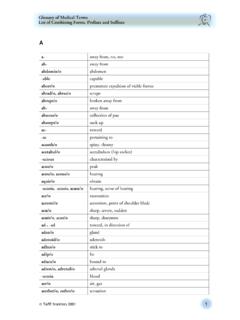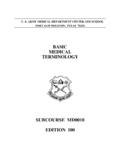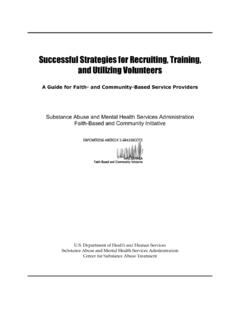Transcription of Training Officer Active Duty Service Obligations
1 UNCLASSIFIED Army Regulation 350 100 Training Officer Active Duty Service Obligations Headquarters Department of the Army Washington, DC 26 September 2017 SUMMARY of CHANGE AR 350 100 Officer Active Duty Service Obligations This major revision, dated 26 September 2017 o Clarifies the Service obligation for officers who attend the Advanced Strategic Planning and Policy Program (paras 1 9d and 3 3). o Adds a 2-year Active duty Service obligation for officers reassigned on a permanent change of station to an overseas location upon completing a Military Personnel Exchange Program assignment for officers who do not already have a 2-year Active duty Service obligation (para 2 5). o Adds UH 72A new equipment Training to initial key personnel Training (para 2 6f(1)(a)(3)). o Adds Engineer, Special Forces, and Geospatial Development Programs to military schooling (para 2 6o). o Adds obligation and utilization requirements for the Expanded Graduate School Program (para 3 5b).
2 *This regulation supersedes AR 350-100, dated 8 August 2007. AR 350 100 26 September 2017 UNCLASSIFIED i Headquarters Department of the Army Washington, DC *Army Regulation 350 100 26 September 2017 Effective 26 October 2017 Training Officer Active Duty Service Obligations History. This publication is a major revi-sion. Summary. This regulation establishes guidance on Active duty Service Obligations for officers, defines how Service Obligations will be computed and served, and estab-lishes how officers will be notified of ser-vice Obligations . Applicability. This regulation applies to the Active Army, the Army National Guard/Army National Guard of the United States, and the Army Reserve, unless otherwise stated. During mobilization, this publication has limited application. Proponent and exception authority. The proponent of this regulation is Deputy Chief of Staff, G 1. The proponent has the authority to approve exceptions or waivers to this regulation that are consistent with controlling law and regulations.
3 The propo-nent may delegate this approval authority, in writing, to a division chief within the pro-ponent agency or its direct reporting unit or field operating agency, in the grade of colo-nel or the civilian equivalent. Activities may request a waiver to this regulation by providing justification that includes a full analysis of the expected benefits and must include formal review by the activity s sen-ior legal Officer . All waiver requests will be endorsed by the commander or senior leader of the requesting activity and for-warded through their higher headquarters to the policy proponent. Refer to AR 25 30 for specific guidance. Army internal control process. This regulation contains internal control provi-sions in accordance with AR 11 2 and identifies key internal controls that must be evaluated (see appendix B). Supplementation. Supplementation of this regulation and establishment of com-mand and local forms are prohibited with-out prior approval from the Deputy Chief of Staff, G 1 (DAPE ZXM), 300 Army Pen-tagon, Washington, DC 20310 0300.
4 Suggested improvements. Users are invited to send comments and suggested improvements on DA Form 2028 (Recom-mended Changes to Publications and Blank Forms) directly to Commander, U. S. Army Human Resources Command (AHRC PDP T), 1600 Spearhead Divi-sion Avenue, Department 400, Fort Knox, KY 40122 5400. Distribution. This publication is availa-ble in electronic media only and is intended for command levels B, C, D, and E for the Active Army, the Army National Guard/Army National Guard of the United States, and the Army Reserve. Contents (Listed by paragraph and page number) Chapter 1 General, page 1 Purpose 1 1, page 1 References 1 2, page 1 Explanation of abbreviations and terms 1 3, page 1 Responsibilities 1 4, page 1 Scope 1 5, page 1 Statutory authority 1 6, page 1 Applicability 1 7, page 1 Purpose of Active duty Service Obligations 1 8, page 1 Who incurs Active duty Service Obligations 1 9, page 2 Chapter 2 Officer Service Obligation Policies, page 2 General 2 1, page 2 Commissioning 2 2, page 2 Warrant Officer appointment 2 3, page 2 Contents Continued ii AR 350 100 26 September 2017 Promotion 2 4, page 2 Permanent change of station 2 5, page 2 Military schooling 2 6, page 3 Civilian schooling 2 7, page 4 Reserve Officer Training Corps instructors 2 8, page 5 Astronaut Candidate Program 2 9, page 5 Experimental Test Pilot Program 2 10, page 5 Aviation continuation pay 2 11, page 5 Chapter 3 Computation of Service Obligations , page 5 General 3 1.
5 Page 5 Procedures 3 2, page 5 Consecutive Obligations 3 3, page 5 Obligations for specified graduate programs 3 4, page 6 Obligations for graduate school, branch of choice, or post of choice for Active duty Service obligation pro-grams 3 5, page 6 Concurrent Obligations 3 6, page 6 Notification of officers 3 7, page 7 Verification of Active duty Service Obligations 3 8, page 7 Chapter 4 Waivers and Exceptions, page 9 Requests for waiver of Active duty Service Obligations 4 1, page 9 Exceptions 4 2, page 9 Chapter 5 Army National Guard Officer Active Service Obligation Policies, page 10 General 5 1, page 10 Obligations for specified programs 5 2, page 10 Concurrent Obligations 5 3, page 10 Waivers and exception 5 4, page 10 Appendixes A. References, page 11 B. Internal Control Evaluation, page 14 Table List Table 3 1: Active duty Service obligation for accepting commissions/long-term extension/warrant Officer graduate school, branch of choice, or post of choice, page 7 Table 3 2: Active duty Service obligation for permanent change of station and promotion, page 8 Table 3 3: Active duty Service obligation for civil schooling, page 8 Table 3 4: Active duty Service obligation for military schooling, page 9 glossary AR 350 100 26 September 2017 1 Chapter 1 General 1 1.
6 Purpose This regulation establishes policies and procedures for the receipt, computation, and notice of Active duty Service obliga-tions (ADSOs) for all commissioned officers and warrant officers serving on the Active duty list. It also describes how ADSOs are served with commissioning ADSOs. 1 2. References See appendix A. 1 3. Explanation of abbreviations and terms See the glossary . 1 4. Responsibilities a. The Deputy Chief of Staff, G 1 is responsible for developing policy pertinent to ADSOs. b. Commanding General (CG), Army Human Resources Command (HRC) will implement policy guidance re-ceived from the Office of the Deputy Chief of Staff (ODCS), G 1 regarding Officer ADSOs. The CG, HRC will also receive requests for exception to policy according to paragraph 4 1. c. Headquarters, Department of the Army (HQDA) agencies and commanders will ensure compliance with the AR 25 22 and AR 25 55. 1 5.
7 Scope This regulation governs all Service Obligations incurred after the effective date of this regulation. Service Obligations that were incurred earlier are governed by the regulations in effect at the time they were incurred. If there is a conflict between this regulation and other Army publications, the policies in this regulation take precedence. 1 6. Statutory authority ADSOs for officers are governed in part under Sections 651, 2005, 2007, 2103a, 2104, 2107, 2123, and 4348, of Title 10, United States Code (USC). 1 7. Applicability a. This regulation applies to all commissioned and warrant officers on the Active duty list and those serving in the Army Reserve (USAR) Active Guard Reserve (AGR) Program. b. Specific policies on Service Obligations for Army Medical Department (AMEDD) officers are in AR 351 3. Policies on Service Obligations for Judge Advocate General s Corps (JAGC) officers taking part in the Judge Advocate General s Funded Legal Education Program are contained in AR 27 1.
8 C. Chapter 5 of this regulation applies to all Army National Guard (ARNG) AGR officers. 1 8. Purpose of Active duty Service Obligations a. The ADSOs are intended to assist the Army in (1) Effectively managing its resources. (2) Accomplishing its assigned mission. (3) Maintaining an experienced and well-qualified Officer force. (4) Ensuring a reasonable return to the Army following the expenditure of public funds. b. Public funds are expended starting with the commissioning phase, through Training at the United States Military Academy (USMA), Army Reserve Officers Training Corps (ROTC), and other commissioning programs. It continues when an Officer enters Active duty and enters Training or education programs to qualify for a certain specialized classifica-tion skill. c. There are other ADSOs that are not directly related to the investment of public funds. These are incurred because of promotion to certain grades or permanent change of station (PCS).
9 These ADSOs have been developed to ensure a reason-able degree of stability in the Officer force. d. For the career-oriented Officer , Service under an ADSO is not particularly significant, except that it may affect the date of retirement. Additional Service , because of ADSOs, is more important since voluntary separation from Active duty 2 AR 350 100 26 September 2017 may be precluded until all ADSOs are fulfilled. Therefore, officers must thoroughly understand the system by which the Army determines ADSOs. 1 9. Who incurs Active duty Service Obligations a. Generally, officers who complete certain formal education or Training programs, undergo a PCS, or receive certain promotions incur an ADSO. b. Officers must fulfill ADSOs before they are eligible for voluntary separation. The ODCS, G 1, may grant nonstatu-tory exceptions. c. Officers will not be further obligated beyond the dates voluntary ADSOs are fulfilled without their consent, either expressed or implied.
10 D. Officers who attend military and or civilian courses of instruction as stated in paragraphs 2 6 and 2 7 may incur an ADSO for up to 6 years on completion or termination from the course(s). Exceptions are (1) Officers who attend civil schooling under AR 621 7 may exceed the 6-year maximum ADSO. (2) Officers who attend the Advanced Strategic Planning and Policy Program (ASP3) which consists of non-consecu-tive phases of resident civil schooling incur a maximum 6-year ADSO when considering all phases in total. Officer eval-uation report (OER) producing assignments between non-consecutive schooling phases is credited towards satisfying ADSO. Chapter 2 Officer Service Obligation Policies 2 1. General Officers entering military Service must complete a total of 8 years military Service obligation. Service will be on Active duty or in the Reserve Components, in either enlisted or Officer status (10 USC 651). (See tables 3 1 through 3 4 for ADSOs.)

















